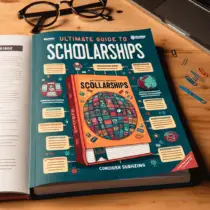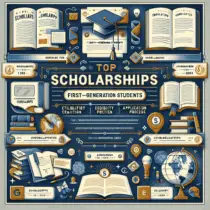Securing scholarships is one of the best ways to ease the financial burden of pursuing higher education. College tuition costs continue to rise, making it essential for students to find alternative sources of funding. Scholarships are a fantastic option because they do not need to be repaid, unlike student loans. However, the process of securing scholarships can sometimes be overwhelming and confusing for students and their families. That’s why having an ultimate guide to securing scholarships is crucial for anyone looking to offset the cost of college.
In this comprehensive guide, readers will learn everything they need to know about finding, applying for, and winning scholarships. From tips on how to search for scholarships that best fit their needs to strategies on how to write a winning scholarship essay, this guide covers all the essential steps in securing scholarships successfully. By following these tips and advice, students can increase their chances of receiving financial aid for their education and achieving their academic goals. So let’s dive into the ultimate guide to securing scholarships!
Researching Scholarships
Before applying for scholarships, it is essential to conduct thorough research on available opportunities. There are numerous resources where students can find scholarship information, such as online scholarship databases, college websites, community organizations, and guidance counselors. Students should make a list of potential scholarships they qualify for based on eligibility criteria like academic achievements, extracurricular activities, community service, or specific demographics.
Once students have identified potential scholarship opportunities, they should prioritize them based on deadlines and requirements. Some scholarships may require additional materials like recommendation letters or transcripts, so it’s crucial to stay organized and keep track of all application deadlines. Additionally, students should pay attention to any specific instructions or essay prompts provided by scholarship sponsors.
Crafting a Standout Application
Writing a compelling scholarship application is key to standing out among other applicants. When crafting a scholarship essay or personal statement, students should showcase their unique qualities, experiences, and aspirations that make them deserving of financial aid. It’s essential to tailor each application to fit the specific requirements of each scholarship and demonstrate genuine interest in the organization or cause offering the award.
Moreover, proofreading and editing are crucial steps in creating a polished application that leaves a lasting impression on selection committees. Students should have someone else review their essays for grammar errors, typos, and clarity before submitting them. A well-written essay can make a significant difference in winning a scholarship over other candidates with similar qualifications.
Seeking Alternative Funding Sources
In addition to traditional merit-based scholarships offered by colleges and organizations, students should explore alternative funding sources like grants, fellowships, work-study programs, and crowdfunding platforms. If eligible, some federal grants, such as the Pell Grant, may provide financial assistance based on financial need. Students interested in research or specific fields may also find fellowship programs that offer funding for graduate studies or projects.
For those who prefer working part-time while studying, campus work-study programs can offer flexible job opportunities that sync with academic schedules. Additionally, crowdfunding platforms like GoFundMe or Kickstarter enable students to raise funds from friends, family, and supporters willing to contribute towards educational expenses. These alternative funding sources expand opportunities for financial assistance beyond traditional scholarships.
Applying Strategically
When applying for multiple scholarships, it’s essential to develop a strategic approach to maximize success. Students should carefully review each scholarship’s requirements, priority, duplication policies, and submission details. To streamline the process, students may create templates to illustrate their qualifications, arrangements, and accomplishments; this makes it easier to customize applications for different scholarships quickly.
Furthermore, sourcing letters of recommendation, easily accessible transcripts, and other supplemental materials can save time during the application process. Students should submit applications early to maximize their chances of being considered. For a large variety of scholarship possibilities, students may consider organizing a portfolio to store documents efficiently. This will help them stay organized throughout the application process and avoid missing key deadlines or submission requirements.
FAQ (Frequently Asked Questions)
1. What are some common eligibility criteria for scholarships? Common eligibility criteria include academic achievements, GPA minimums (usually 3.0 or above), extracurricular activities, volunteer experience, race/ethnicity, and field of study. Foundations, associations, and corporations may offer scholarships based on a variety of factors, so it’s important to check scholarship details carefully.
2. How many scholarships should I apply for? There is no limit to how many scholarships you can apply for, but it is essential to manage your time effectively to avoid feeling overwhelmed. Focus on quality over quantity by targeting scholarships that best match your qualifications and interests.
3. Should I pay for a scholarship search service? Avoid paying for any scholarship search services that claim to guarantee you will receive a scholarship. For free options, you can use reputable websites like Fastweb.com, Scholarships.com, and BigFuture.collegeboard.org. It’s important to prioritize using legitimate resources that do not require payment or personal information.
4. What happens if I win more than one scholarship? If you win more than one scholarship, you can most likely accept all winnings. By contacting each scholarship sponsor, you can clarify basic guidelines about accepting multiple awards. In some cases, you may be required to report all winnings and additional financial aid sources to your school or state agencies to ensure compliance with regulations.
Conclusion
The ultimate guide to securing scholarships offers valuable tips and strategies for students seeking financial assistance to further their educational goals. By conducting thorough research, crafting standout applications, seeking alternative funding sources, and applying strategically, students can improve their chances of receiving scholarship awards. This guide provides comprehensive information and resources that will equip students with the necessary tools to navigate the complexities of securing financial aid opportunities. Don’t miss out on potential scholarship opportunities; start your search today!






